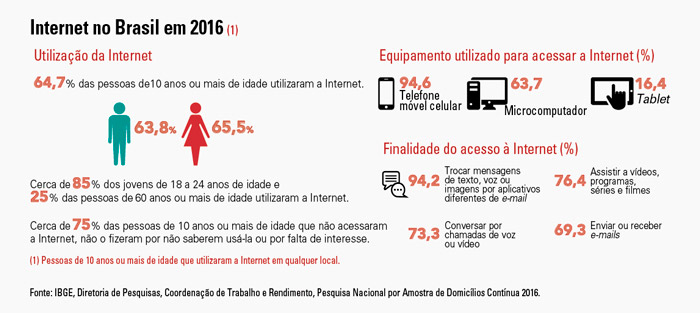Messaging apps for nine out of ten Internet users in the country
February 21, 2018 10h00 AM | Last Updated: February 21, 2018 12h15 PM
Of the country's 116.1 million people who accessed the Internet in 2016, almost everyone (92.4%) used messaging applications (emails were not considered in this calculation). Emails were used by 69.3% of the netizens. The purposes of Internet access were put out today in the module Information and Communication Technology of the Continuous PNAD, which surveys data on Internet, TV and Mobile phones.
Other Internet uses which were identified were to watch videos, shows, TV series and movies (76.4%) and to make phone and video calls (73.3%). According to the manager of the survey, Maria Lucia Vieira, sending and receiving emails were the major purposes for the Internet access in 2005; today, however, such use is usually restricted to work situations: "this result shows that people prefer forms of communication which are faster and easier, as those offered by mobile apps", she says.


Maria Lucia highlights that the need for agility sending and receiving messages is related to the prevalence of mobile access to the Internet, which was used by 94.6% of those who accessed the Internet in 2016. "Mobile access surpasses 90% in all Major Regions. Besides being faster, the mobile phone allows access to the Internet by free or public wireless networks which do not require data transmission network."
Despite the prevalence of mobile phones (94.6%), there are other forms of Internet access: through personal computers (63.7%), tablets (16.4%) and TV sets (11.3%). In the North and Northeast, the use of personal computers is lower, which could be explained by the lowest income of population and the local infrastructure. "The household income of those two Major Regions is below that of the others, and both personal computers and Internet services for PCs are more expensive than mobile phones.
Mobile broadband is the main kind of connection for households
The survey identified that 77.3% of the households used mobile broadband and 71.4%, fixed line broadband; whereas 49.1% used both kinds. In the North, half of the households (50.9%) were connected to the Internet through mobile broadband. More and more irrelevant, the dialed connection was identified in only 0.6% of the households.
The survey manager emphasizes the differences found in the broadband survey in the country: "this survey has been conducted in partnership with the Ministry of Science, Technology, Innovation and Communication for five years. At the beginning, there was still a significant percentage of households that used dialed connection. However, the mobile broadband has a greater percentage than the fixed line broadband, which is related to the greater use of mobile phones to access the Internet," she claims.


















